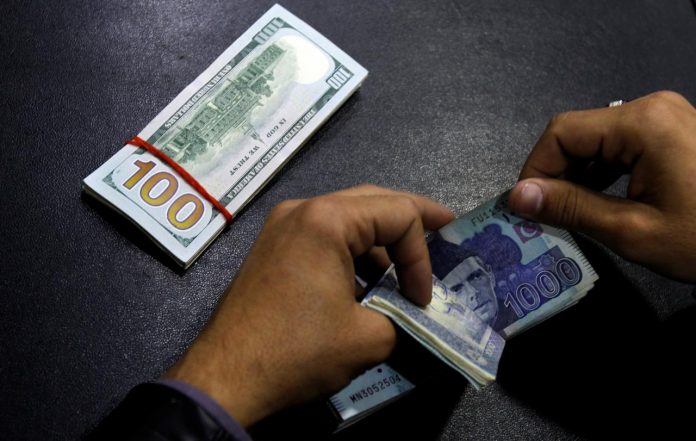
LAHORE: The rupee nosedived by Rs1.31 against the dollar on Monday in the inter-bank market as it was traded between Rs133.20-133.63, before closing at Rs133.25.
After an initial decline of Rs1.57 against the dollar, the rupee recovered Rs0.32 of its value to trade at Rs133.40 before closing at Rs133.25 in the inter-bank market on Monday.
In the kerb market, the rupee shed Rs0.7 against the dollar and was being traded at Rs133.70.
The KSE-100 index plunged over 1,200 points in intra-day trading on Monday to a two-year low of 36,274.25 points before recovering to close at 36,767.57 points, down 750.36 points from Friday.
“Volatility in the inter-bank dollar rate is due to the economic uncertainty, where some punters believe the currency could stabilize near current levels given the fact that we have knocked on the IMF’s door and their dollars appear to be around the corner,” said Pak Kuwait Investment Co AVP Research Adnan Sheikh.
“While on the flip side some (including myself) expect further depreciation as the currency is still overvalued, imports are still at par, and both SBP and IMF have quoted higher levels for the dollar,” he added.
“As for the hawala and hundi systems, the exchange companies need to be regulated more stringently as they are the only supply of dollars to the public,” explained Mr Adnan.
While speaking to Profit, Topline Securities’ analyst Nabeel Khursheed said, “There is no cluelessness on part of the government which is contrary to what you see in the media. It has so far has taken bold measures which were non-populist and has severely undermined the government’s position in the by-elections.”
“They have now officially approached IMF and hopefully, we will soon see a further update on the total bailout package and expected amount disbursement date. It’s only a matter of time,” he added.
He explained to address the continuing uncertainty the government can do is to hold a press brief with FM taking investors and businesses into confidence.
“The rupee fluctuation has to do with speculations in the market as to when the Govt will get IMF support package,” he added.
On Friday, the rupee had regained a further Rs1.87 or 1.4% against the dollar in inter-bank trading to close at Rs131.9318.
Inter-bank trading exhibited a volatile trend as the rupee strengthened by Rs1.40 against the greenback, as it regained its value from an all-time low of Rs133.6431 touched on Tuesday.
This is the fifth devaluation of the rupee since December 2017, which has seen the local currency losing a cumulative 27% of its value against the greenback.
On Thursday, the country’s foreign exchange reserves plunged by another $100 million to $8.3 billion which was barely enough to provide 1.5 months of import cover, as per the central bank.
The Finance Minister Asad Umar upon his return from Bali, Indonesia on Saturday addressed a press conference and said, “If one rupee is devalued against the dollar, the burden of debt increases by Rs95 billion. Previous governments are responsible for the same.
He added the only way to stabilize rupee was to increase the country’s exports, for which the new government has taken various steps like incentives to the textile sector and the removal of regulatory duties.
According to a Renaissance Capital report, the Pakistani rupee was the cheapest currency in South Asia.
It shared that last week’s devaluation took the rupee to just 4% below its long-term average rate (1995-2018).
Moreover, it considers Pakistan among the three vulnerable emerging markets alongside Turkey and Argentina and one investor told them the IMF is looking for rupee at Rs147 to a dollar – which would take it to a 13% discount to the long-term average rate.
The report highlighted that the rupee has never been weaker than Rs147 per US dollar – which is the equivalent level that their model told the PKR got to in September 2001.
It projected that the rupee will settle at around Rs140 per dollar (best case) to Rs160 per dollar and beyond Rs160 per dollar would be their worst-case scenario – (e.g. if IMF talks were to fail).
Pakistan has been facing a crisis on the external front, with burgeoning trade & current account deficits and depleting foreign exchange reserves.
Pakistan’s gross external financing requirement has been estimated at $22-25 billion for the current financial year FY19.






